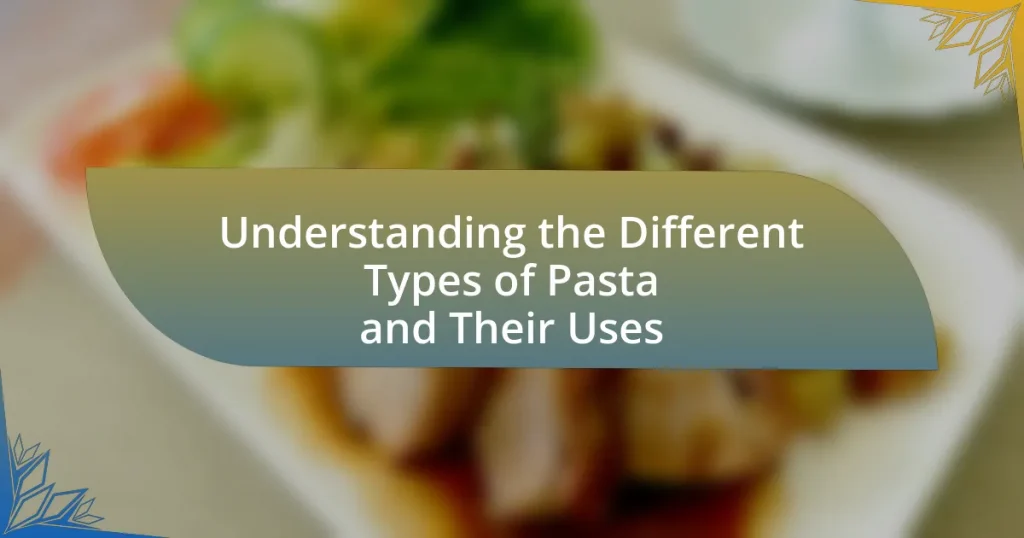The article provides a comprehensive overview of the various types of pasta, categorizing them by shape, size, and culinary uses. It discusses the main categories of pasta, including fresh, dried, and specialty varieties, and explains how shape influences cooking times and sauce pairings. Additionally, the article outlines the best cooking methods for different pasta types and offers tips for selecting the right pasta based on the dish’s sauce and texture. It also addresses common cooking mistakes and best practices for storing leftover pasta, ensuring optimal flavor and quality in pasta dishes.

What are the Different Types of Pasta?
There are several different types of pasta, each with unique shapes and uses. Common types include spaghetti, which is long and thin, ideal for sauces; penne, a tubular pasta that holds sauce well; fusilli, spiral-shaped pasta that captures ingredients; and lasagna, flat sheets used in layered dishes. Other varieties include farfalle, resembling butterflies, and ravioli, which are stuffed pasta pockets. Each type of pasta has specific culinary applications, making them versatile in various recipes.
How are pasta types categorized?
Pasta types are categorized primarily by their shape and size, which influences their culinary uses. Common categories include long pasta, such as spaghetti and fettuccine; short pasta, like penne and fusilli; and stuffed pasta, such as ravioli and tortellini. Each shape is designed to hold sauces differently, with long pasta typically pairing well with lighter sauces and short pasta often used in baked dishes or salads. This categorization is rooted in traditional Italian cooking practices, where specific pasta shapes are matched with particular types of sauces to enhance flavor and texture.
What are the main categories of pasta?
The main categories of pasta are fresh pasta, dried pasta, and specialty pasta. Fresh pasta is made from flour and eggs, resulting in a tender texture, and is often used in dishes like ravioli and fettuccine. Dried pasta, made from durum wheat semolina and water, has a longer shelf life and is commonly used in various recipes, such as spaghetti and penne. Specialty pasta includes unique shapes and ingredients, such as whole grain or gluten-free options, catering to diverse dietary needs and preferences.
How does shape influence pasta classification?
Shape is a primary factor in pasta classification, as it determines the pasta’s texture, cooking time, and suitability for various sauces. Different shapes, such as long strands like spaghetti or short shapes like penne, influence how the pasta interacts with ingredients, affecting the overall dish. For instance, ridged shapes like rigatoni hold onto sauces better than smooth shapes, making them ideal for hearty, chunky sauces. This classification system is recognized in culinary traditions, where specific shapes are traditionally paired with certain types of sauces to enhance flavor and texture.
What are the most common pasta shapes?
The most common pasta shapes include spaghetti, penne, fusilli, and macaroni. Spaghetti is a long, thin noodle often used in various Italian dishes, while penne features a tubular shape with angled ends, making it ideal for holding sauces. Fusilli, characterized by its spiral shape, is excellent for capturing bits of vegetables and meat in sauces. Macaroni, a small, curved tube, is frequently used in baked dishes like macaroni and cheese. These shapes are widely recognized and utilized in culinary practices around the world, reflecting their versatility and popularity in pasta dishes.
What is the origin of popular pasta shapes?
The origin of popular pasta shapes can be traced back to ancient civilizations, particularly in Italy, where pasta was first documented in the 12th century. The shapes evolved based on regional ingredients, cooking methods, and cultural influences. For instance, shapes like spaghetti and fettuccine emerged from the southern regions of Italy, while stuffed varieties like ravioli originated in the north, reflecting local culinary traditions. Historical records indicate that the introduction of durum wheat in the 19th century further influenced the development of various pasta shapes, as it allowed for the creation of firmer and more versatile pasta.
How do different shapes affect cooking times?
Different shapes of pasta affect cooking times due to variations in surface area and thickness. For instance, thinner shapes like angel hair cook faster, typically in 2-4 minutes, while thicker shapes like penne may take 11-13 minutes. The increased surface area of smaller shapes allows for quicker heat absorption, leading to shorter cooking times. Conversely, larger or denser shapes require more time to ensure even cooking throughout. This principle is supported by culinary guidelines that recommend specific cooking times based on pasta shape, ensuring optimal texture and doneness.

What are the Uses of Different Pasta Types?
Different pasta types serve various culinary purposes based on their shapes and textures. For example, spaghetti is ideal for long, thin sauces like marinara, while penne, with its tubular shape, is perfect for holding onto thicker sauces such as pesto or creamy Alfredo. Fusilli, with its spiral shape, is often used in salads or baked dishes because it captures ingredients well. Lasagna sheets are specifically designed for layering in baked dishes, providing structure and texture. Additionally, small pasta shapes like orzo and ditalini are commonly used in soups, adding substance without overwhelming the dish. Each pasta type’s unique characteristics enhance specific recipes, making them essential in diverse culinary applications.
How do specific pasta types pair with sauces?
Specific pasta types pair with sauces based on their shape and texture, which influence how well they hold onto the sauce. For example, spaghetti, a long and thin pasta, pairs well with light sauces like marinara or olive oil, allowing the sauce to coat the strands evenly. Conversely, rigatoni, with its ridges and tubular shape, is ideal for thicker sauces such as meat ragù, as the sauce clings to the pasta’s surface and fills the tubes. Similarly, delicate pasta like angel hair works best with light, oil-based sauces, while hearty shapes like farfalle complement creamy sauces due to their ability to trap the sauce in their folds. This pairing principle is rooted in culinary tradition, where the characteristics of pasta are matched to enhance the overall dish.
What sauces complement long pasta varieties?
Long pasta varieties, such as spaghetti, fettuccine, and linguine, are complemented by sauces that adhere well to their surface. Classic sauces that pair effectively include marinara, Alfredo, carbonara, and pesto. Marinara, a tomato-based sauce, provides a rich flavor that enhances the pasta’s texture. Alfredo, made from butter and cream, creates a creamy coating that clings to long strands. Carbonara, featuring eggs, cheese, and pancetta, offers a savory depth that complements the pasta’s form. Pesto, made from basil, garlic, and nuts, adds a fresh, aromatic quality that pairs well with the long shapes. These sauces are widely recognized in Italian cuisine for their compatibility with long pasta, ensuring a satisfying dining experience.
Which sauces work best with short pasta shapes?
Short pasta shapes pair best with thicker, chunkier sauces that cling well to their surfaces. Examples include marinara, pesto, and creamy sauces like Alfredo. These sauces enhance the texture and flavor of short pasta, allowing for a satisfying bite. Marinara, a tomato-based sauce, is commonly used due to its acidity and richness, while pesto, made from basil and nuts, adds a fresh, herbal note. Creamy sauces like Alfredo provide a rich, velvety coating that complements the pasta’s shape.
What are the best cooking methods for various pasta types?
The best cooking methods for various pasta types include boiling, baking, and sautéing. Boiling is the primary method for most pasta types, such as spaghetti and penne, where pasta is cooked in salted water until al dente, typically taking 8 to 12 minutes depending on thickness. Baking is ideal for pasta types like lasagna and cannelloni, where layered pasta is combined with sauce and cheese, then baked until bubbly, usually around 30 to 45 minutes at 350°F. Sautéing is effective for fresh pasta types like fettuccine or gnocchi, where cooked pasta is quickly tossed in a pan with sauce or vegetables for added flavor, often taking just a few minutes. These methods ensure optimal texture and flavor for each pasta type, aligning with traditional culinary practices.
How does boiling time vary among pasta types?
Boiling time varies significantly among different types of pasta, typically ranging from 2 to 12 minutes. For example, thin pasta varieties like angel hair require about 2 to 4 minutes, while standard spaghetti takes approximately 8 to 10 minutes. In contrast, thicker pasta types such as penne or rigatoni generally need around 10 to 12 minutes to cook properly. This variation is due to differences in thickness, density, and surface area, which affect how quickly the pasta absorbs water and softens during cooking.
What are alternative cooking methods for pasta?
Alternative cooking methods for pasta include baking, steaming, and using a microwave. Baking pasta, such as in casseroles, allows for a different texture and flavor profile, often enhancing the dish with cheese and sauce. Steaming pasta can be effective for certain types, like dumplings or filled pasta, where moisture is retained without boiling. Microwaving pasta is a quick method that can be used for reheating or cooking small portions, where water is added to the pasta in a microwave-safe container. These methods provide versatility in preparing pasta dishes beyond traditional boiling.

How to Choose the Right Pasta for Your Dish?
To choose the right pasta for your dish, consider the sauce and ingredients you will use. For example, thicker sauces pair well with robust pasta shapes like rigatoni or pappardelle, while lighter sauces complement delicate pasta such as angel hair or spaghetti. The texture of the pasta also matters; rough surfaces hold onto sauces better, making shapes like fusilli or farfalle ideal for chunky sauces. Additionally, the cooking time varies among pasta types, so ensure the pasta can be cooked to the desired doneness in sync with your dish preparation.
What factors should you consider when selecting pasta?
When selecting pasta, consider the type of dish you are preparing, as different pasta shapes and sizes complement various sauces and ingredients. For instance, long pasta like spaghetti pairs well with lighter sauces, while short pasta such as penne is ideal for thicker, chunkier sauces. Additionally, assess the pasta’s texture, as rough surfaces hold sauce better, enhancing flavor. The cooking time is also crucial; fresh pasta cooks faster than dried pasta, impacting meal preparation. Lastly, consider dietary needs, such as gluten-free options, which are increasingly available and cater to specific health requirements.
How does the dish’s sauce influence pasta choice?
The dish’s sauce significantly influences pasta choice by determining the texture and shape of the pasta that best complements the sauce’s consistency and flavor profile. For instance, thicker sauces, such as a hearty Bolognese, pair well with wide, flat pasta like pappardelle, which can hold onto the sauce effectively. Conversely, lighter sauces, such as a delicate olive oil or garlic sauce, are better suited for thin pasta like angel hair, allowing the sauce to coat the strands without overwhelming them. This pairing is supported by culinary principles that emphasize balance and harmony in flavor and texture, ensuring that the pasta enhances the overall dish rather than detracting from it.
What role does texture play in pasta selection?
Texture plays a crucial role in pasta selection as it influences the pasta’s ability to hold sauces and its overall mouthfeel. Different textures, such as smooth or ridged surfaces, affect how well the pasta adheres to sauces; for instance, ridged pasta like rigatoni captures thicker sauces better than smooth pasta like spaghetti. Additionally, the texture can enhance the eating experience, with certain shapes providing a more satisfying bite. Studies indicate that the surface texture of pasta can significantly impact consumer preferences, as texture contributes to perceived quality and enjoyment during consumption.
What are some tips for cooking pasta perfectly?
To cook pasta perfectly, use a large pot of boiling salted water and cook the pasta until al dente, which typically takes 8 to 12 minutes depending on the type. Salting the water enhances the pasta’s flavor, and cooking it al dente ensures it retains a firm texture. According to the USDA, the recommended ratio is about 1 tablespoon of salt per 4 to 6 quarts of water. Stir the pasta occasionally to prevent sticking, and reserve some pasta water before draining to adjust the sauce’s consistency if needed.
How can you avoid common pasta cooking mistakes?
To avoid common pasta cooking mistakes, ensure you use a large pot with plenty of water to prevent sticking. Cooking pasta in insufficient water leads to clumping, as the starch released during cooking needs space to disperse. Additionally, always salt the water before boiling; this enhances flavor and helps the pasta absorb seasoning. Cooking pasta for the recommended time on the package and tasting for doneness prevents overcooking, which can result in mushy texture. Finally, avoid rinsing cooked pasta, as this washes away the starch that helps sauces adhere. These practices are supported by culinary experts who emphasize the importance of proper technique for optimal pasta preparation.
What are the best practices for storing leftover pasta?
The best practices for storing leftover pasta include refrigerating it in an airtight container within two hours of cooking. This method prevents bacterial growth, as food left at room temperature for more than two hours can become unsafe to eat. Additionally, separating pasta from sauces before storage can help maintain texture and flavor, as sauces can cause pasta to become mushy over time. Leftover pasta can be stored in the refrigerator for up to three to five days. For longer storage, freezing is an option; cooked pasta can be frozen for up to three months, ideally in a single layer to prevent clumping.















